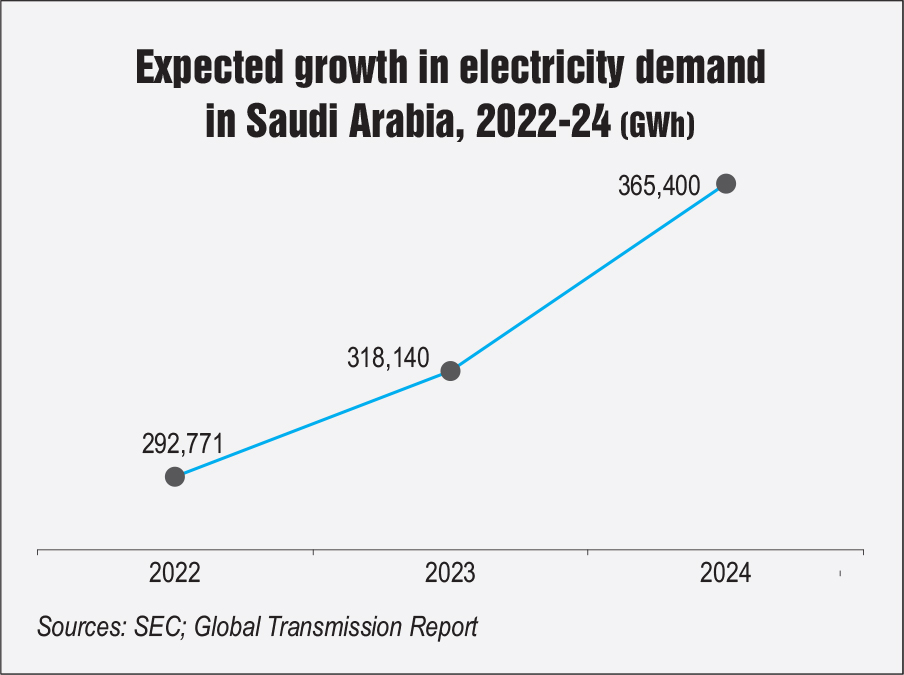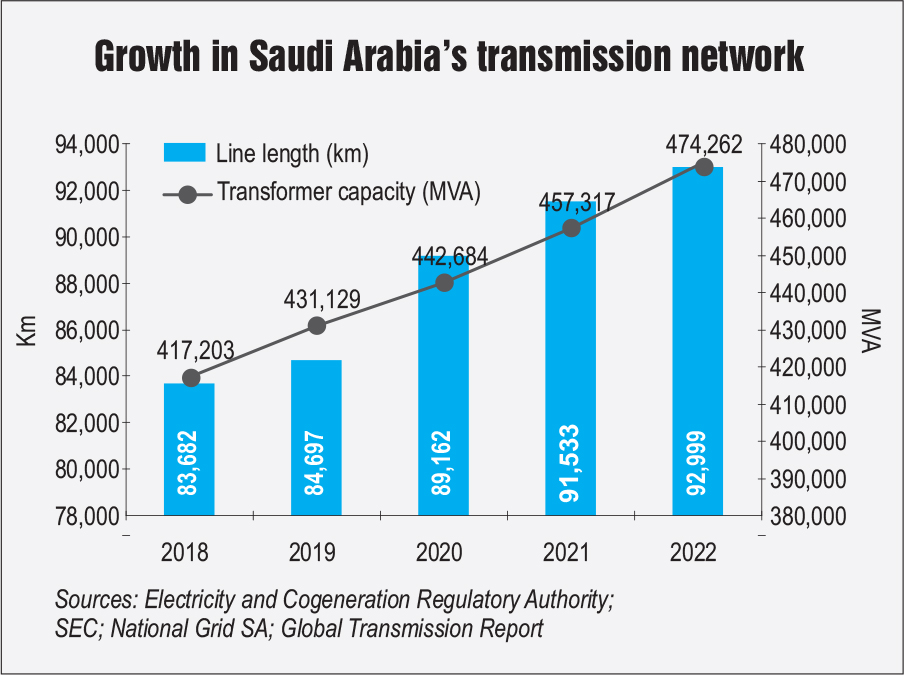Saudi Arabia has a robust and extensive transmission network that serves as the backbone of its electricity infrastructure. It plays a critical role in ensuring reliable power supply and supporting the country’s economic growth. Saudi Arabia has been actively pursuing electricity transmission ties with neighbouring countries, fostering regional cooperation and bolstering energy security. With the increasing global focus on the transition to low-carbon economies, the country aims to reduce its carbon emissions by decreasing dependence on fossil fuels. The oil-rich country has set a target of generating half of its electricity over the next decade from clean energy sources, which is in line with the kingdom’s Vision 2030. It is estimated that the country’s installed capacity will increase from over 83 GW in 2022 to approximately 118 GW by 2030, achieved with a combination of 50 per cent natural gas and 50 per cent renewable energy sources (RES). The Ministry of Energy’s spending on power and RES projects is expected to reach $293 billion by 2030.
To fully utilise the upcoming capacity, optimise operating costs and increase regional power exchange, state-owned electric company Saudi Electricity Company (SEC), through its wholly owned transmission subsidiary, National Grid SA, is actively pursuing opportunities to interconnect its grid with those of other countries in the region. Currently, it is working on cross-border interconnectors with Iraq, India, Jordan and Egypt. Saudi Arabia is also embracing the energy transition and as it advances towards a more sustainable future, the integration of smart grid technologies becomes increasingly crucial. Smart grid solutions, including smart meters, demand response systems and energy storage, will significantly enhance the efficiency, flexibility and resilience of Saudi Arabia’s transmission network.
Key growth drivers for transmission infrastructure expansion
Saudi Arabia plans to transform its generation mix. It proposes to revamp its existing installed generation capacity of 83.4 GW as of December 2022, which is predominantly based on thermal sources such as natural gas, crude oil, diesel and heavy fuel oil, accounting for nearly 99.5 per cent of the total. According to the National Renewable Energy Program (NREP), the RES target for 2030 is 58.7 GW, of which 40 GW will be based on solar PV, 16 GW on wind and 2.7 GW on concentrated solar power. To achieve the planned capacity, more than 35 renewable energy parks will be established across the country. The NREP will drive the adoption of new RES technologies, facilitate private sector investment and encourage public-private partnerships. In addition to RES capacity, the country plans to add approximately 5,000 MW of conventional capacity and 2,800 MW of nuclear capacity by 2030. Another key driver is the expected growth in the country’s electricity demand from 2,92,771 GWh in 2022 to 3,65,400 GWh by 2030. To meet this demand, the country is focusing on harnessing its RES potential.
Existing transmission infrastructure and future plans
As of 2022, Saudi Arabia’s transmission network spanned about 92,999 ckt. km in terms of line length at the 132 kV to 380 kV levels. Between 2018 and 2022, Saudi Arabia’s transmission network grew at a compound annual growth rate (CAGR) of 2.7 per cent, with net additions of close to 9,317 ckt. km. The country’s transmission network saw significant growth at the 230 kV and 380 kV levels, which increased from just 37,783 ckt. km in 2018 to 49,649 ckt. km in 2022. Transformer capacity stood at 474,262 MVA as of 2022, recording a CAGR of 3.3 per cent compared to 417,203 MVA in 2018.


The National Grid has ambitious plans to expand its transmission network in order to minimise congestion, interconnect isolated regions and connect new power plants to the grid. The company and its parent SEC are working with the Ministry of Energy’s Renewable Energy Project Development Bureau to integrate renewable energy plants into the grid. Further, it has been focusing on the adoption of hybrid technology for its existing and upcoming substations, positioning Saudi Arabia as the first country in the Middle East to adopt the hybrid gas-insulated switchgear (GIS) technology. The National Grid also plans to implement grid links to strengthen regional cross-border interconnections and construct new high capacity lines connecting to neighbouring Gulf countries. Over the next three years (2023-25), the National Grid plans to add over 3,600 ckt. km of transmission infrastructure to Saudi Arabia’s grid at an investment of about SAR 5.4 billion.
Saudi Arabia’s role in regional energy integration
Saudi Arabia plays a crucial role in the development of a robust and interconnected regional energy network by actively strengthening electricity transmission ties. These interconnections not only enhance energy security but also promote the efficient utilisation of resources, facilitate RES integration and enable seamless electricity exchange across borders.
Among the Gulf Cooperation Council (GCC) countries, including Bahrain, Kuwait, Oman, Qatar and the UAE, Saudi Arabia has been interconnected since 2012 through a power grid managed by the Gulf Cooperation Council Interconnection Authority (GCCIA). Ongoing efforts aim to strengthen the GCC grid as well as expand it to other neighbouring countries. Recently, in March 2023, the GCCIA awarded a contract to upgrade the Al-Fadhili high voltage direct current (HVDC) converter station in Saudi Arabia to enable the exchange of up to 1,800 MW of electricity among GCC countries.
The following are some of Saudi Arabia’s interconnectors at various stages of planning and development:
- Saudi Arabia-Iraq interconnector: This interconnector aims to facilitate electricity exchange and resource sharing besides strengthening economic ties between the two countries and promoting regional stability. The proposed 1 GW interconnector involves the construction of a 400 kV, 435 km link between the northern Saudi town of Arar and the central Iraqi city of Yusufiya by 2024.
- Saudi Arabia-Egypt link: This 3 GW project, being jointly implemented by the National Grid and Egyptian Electricity Transmission, aims to establish an HVDC link between the two countries. Earlier, in 2023, the Japan Bank for International Cooperation (JBIC) extended a loan of $207 million to SEC for the Saudi side of the project. The project entails the construction of three converter stations – two in Tabuk and Medina in Saudi Arabia and one in Badr in Egypt. Overhead HVDC lines spanning 1,300 km (around 965 km in Saudi Arabia and 335 km in Egypt) and a 20 km submarine cable crossing the Gulf of Aqaba will connect the converter stations. Two switching stations on the shores of the Gulf of Aqaba on both sides will also be constructed to connect the overhead lines and subsea cable. The project will become operational in a phased manner with the first phase expected to be completed by June 2025, enabling the transfer of 1,500 MW and the second phase by November 2025.
- Saudi Arabia-Jordan interconnection: The interconnection aims to enable the sharing of surplus electricity and promote the use of RES in both countries. The National Grid is working with Jordan’s state-owned National Electric Power Company on the project. Initially, it will enable the exchange of around 500 MW of electricity between the two countries, with the possibility to increase it to 1,000 MW in the future. It is part of efforts to establish a joint Arab electricity market that interconnects Arab Gulf countries such as Jordan, Egypt, Palestine, Syria and Iraq. It entails the construction of a 164 ckt. km, 400 kV overhead transmission line between Qurayyat (Saudi Arabia) and East Amman (Jordan), along with a 400 kV GIS substation in Saudi Arabia by 2025.
- Saudi Arabia-Oman interconnection: The project aims to increase the net transfer capacity to Oman from 400 MW to approximately 1,600 MW. It entails the construction of a 700 km, 400 kV HVDC link between the Sultanate of Oman at Ibri, directly to Salwa in Saudi Arabia. If approved, it will be the second interconnection between the two countries. The first, which has been in operation since 2012, supports transfer of up to 400 MW and can carry up to 800 MW in emergencies. It links Oman’s Main Interconnected System with the power systems of the GCCIA via Abu Dhabi. In 2022, the GCCIA, which operates the transmission system that connects the grids of the GCC member states, announced that it is conducting a detailed study of the project.
- Saudi Arabia-India partnership: Saudi Arabia and India are exploring avenues for an electricity interconnection project. The initiative seeks to establish an undersea transmission link, enabling the exchange of power, enhancing grid stability, and supporting the economic growth and sustainability goals of both countries. This is part of India’s One Sun, One World, One Grid initiative, which envisions creating interconnected green grids to enable countries to meet the targets of the Paris Agreement to prevent the adverse effects of climate change.
Conclusion
Saudi Arabia aims to maximise the benefits of its upcoming generation capacity by developing grid infrastructure for power evacuation and establishing interconnectors with neighbouring countries.
